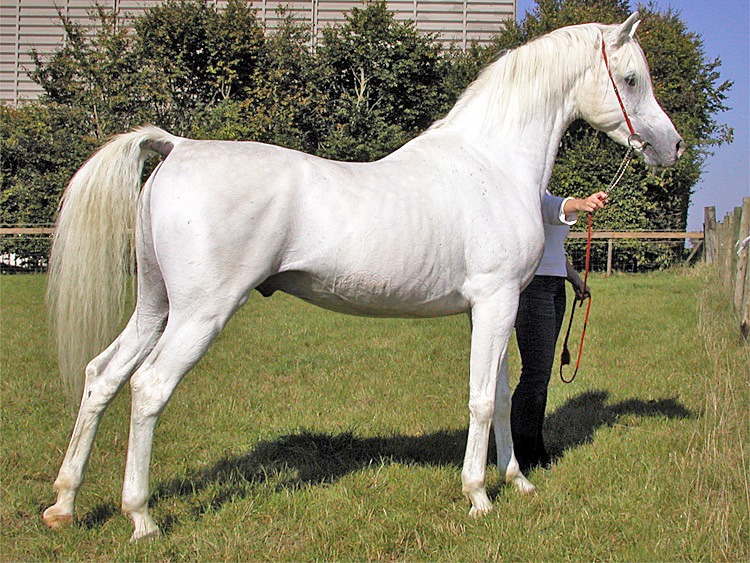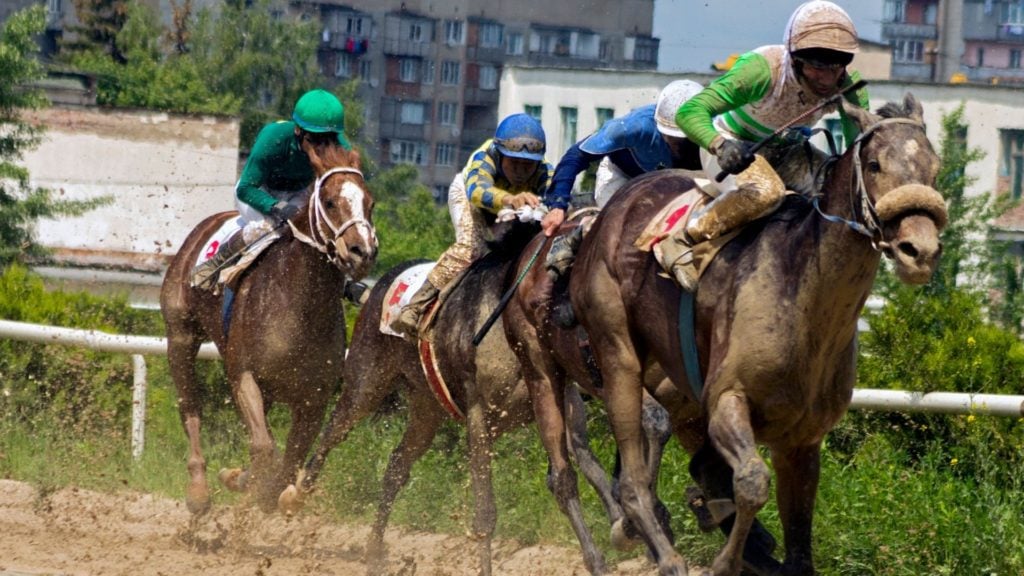Last updated: November 6, 2023
I recently toured an Arabian cutting horse training facility with my grandson. After we left, he had many questions: are they fast, gaited, or expensive? I didn’t have all the answers, so I researched Arabian horses, and this is what I learned:
Arabian horses are fast; they can run upwards of forty miles per hour, quicker than most other horse breeds. They are expensive, but not the most costly of all horses. And finally, Arabians are not naturally gaited, even though some bloodlines of Arabians are gaited.
Arabian horses are cherished for their speed and good looks. But there is much more to this special breed beyond good looks and quickness.

Are Arabian horses fast?
Arabian horses are considered the third-fastest horse breed in the world. That’s pretty amazing when you think there are anywhere from 150 to 217 distinct horse breeds.
The horse breeds faster than Arabians are Quarter horses and Thoroughbreds; researchers in a 2006 study confirmed this.

What horse breed is the fastest?
The researchers looked at videos of the three breeds’ races and calculated acceleration and speed at different intervals and distances. They concluded that Quarter horses are the fastest horse breed. Thoroughbreds were slightly slower, and Arabians were substantially slower than both.
Quarter horses averaged faster speeds and accelerated throughout their races. Thoroughbreds were fastest in the middle of their races and slowed in the final stretches of their races.
Arabian horses are known for their endurance; however, they tend to slow as Thoroughbreds do in races. But in long endurance races that last 100 miles or more, Arabians excel.
Arabian horses and endurance racing
Endurance racing is popular worldwide and is a recognized equestrian sport of the FEI. You’ll see many different horse breeds at an endurance race, but Arabians dominate the sport.
Arabian horses have been selectively bred for thousands of years in the Middle East’s harsh desert regions. Breeders developed them with great endurance to cover vast areas with limited forage.
Arabian horses not only sustained but thrived in the desert. Horse owners took pride in their animals and frequently raced them to determine the best bloodlines.
Because of the extensive distance between tribes, it was essential to have horses that could travel long distances fast. Thus, the races were often more than one hundred miles.
Similar races are still run today and are known as endurance races or endurance rides. The riders and horses are in great shape and travel a hundred miles each day. Some of the competitions span many days.

How long can Arabian horses run?
Arabian horses are known for their endurance and ability to sustain a fast pace over long distances. They can run for long periods, with some even capable of traveling over 100 miles in a single day.
However, the length of time an Arabian horse can run depends on various factors, including the individual horse’s physical condition, training, and the terrain they are running on.
Generally, they can maintain a running pace longer than any other horse breed, two and one-half miles. Most other racing breeds, such as Thoroughbreds and Quarter horses, can’t last past two miles.
Arabian horses have smaller builds and are shorter than Thoroughbreds, which can give them an edge in certain races. While both breeds are known for their speed and endurance, Arabians are generally capable of sustaining a running pace for longer distances, making them well-suited for endurance-riding competitions.
Arabian horse racing.
Arabians run standard flat track races as well as endurance races. The races are restricted to their breed, and although they are entertaining, their top speeds are not close to the horse racing records seen in Thoroughbred or Quarter horse racing.
We don’t have sanctioned Arabian horse racing in Louisiana; however, there are many locations in California and a few others with sanctioned Arabian horse races. You can click on this link for a list of tracks around the country that host Arabian horse racing.
Are Arabian horses expensive?
Arabian horses are expensive horses; their average price is about 5,000 dollars. However, a horse’s price is determined by its pedigree, age, training, and ability. Not all horses of the same breed cost the same.
The Arabians we saw at the cutting horse facility were extremely expensive. Some were offered for sale for well over 50,000 dollars. Of course, these horses were finished and ready for competition.
I also knew a person who rode Arabians in polo competitions. He paid dearly for a finished Arabian polo pony. A well-trained horse is worth a lot in competitive equine eventing, and people spend big money for a winner.
With the above in mind, some Arabians are also for sale at reasonable prices. Click here to visit the equinenow.com website. The link will bring you to the section selling Arabians, where you can find horses for sale at all price levels and various training and breeding.
In the 1980s, purebred Arabian prices skyrocketed, and many people considered them an investment to get rich quickly. During this time, the market multiplied, but the growth didn’t last.

You can read a good story about the Arabian horse market’s rise and fall by clicking this link.
What is the most expensive Arabian horse?
Padron, a Dutch-born stallion, is the most expensive Arabian horse; he was syndicated in 1982 for eleven million dollars. He was a real-world champion, claiming titles in Europe and North America. His command of the arena, exceptional movement, and striking good looks made him legendary.
After arriving in the United States in 1978, he won the Canadian National Championship in halter in 1981 and the U.S. National Champion Stallion title in 1982.
Padron had a successful stud career, siring over 50 winners of national competitions.
The most expensive Arabian mare.
Pepita, a 10-year-old mare, sold at auction for 1.6 million dollars. This mare was the National Champion Senior Mare in Poland and had superior breed conformation.
Her ability to pass champion qualities to offspring is one reason for Pepita’s high selling price. One of her daughters has already made the cover of magazines, displaying the superior characteristics she inherited from her mother.
I’m sure Pepita’s new owners expect a bright future for her as both a broodmare and a competitor.
The most expensive horse breed in the world.
Thoroughbred racehorses are the most expensive horses in the world. Although Arabian horses are expensive, they don’t come close to the prices that elite Thoroughbreds sell. For example, 2000 Kentucky Derby winner Fusaichi Pegasus sold for $70 million.
At the 2020 Keeneland Yearlings Sales, the average price for the yearlings sold was $101,643, and the sale topper was a colt by Tappit; it brought 2 million alone—fifteen horses not yet two years old, sold for over 1 million dollars apiece.
The Keeneland Yearling sale is the premier auction for racing prospects in the World.
Are Arabian horses gaited?
Arabian horses are not classified as gaited horses despite their distinctive high-stepping gait known as the “Arabian trot.” Gaited horses have an intermediate gait in addition to the walk, trot, and canter.
However, individual horses can display unique traits, and some Arabians may show gaited characteristics. While it is not typical of the breed, there are some examples of gaited Arabians. You can find more information on this topic by clicking on this link.
Gaited horse breeds naturally travel in specific footfall patterns where one of their feet is always on the ground. This moving style creates a smooth ride because there is little fall between the animal’s steps.
Gaited horses also use less energy when traveling, allowing them to travel longer and further than traditional non-gaited horses. There are many types of gaits, such as flat walk, running walk, and four-beat.
Popular gaited horse breeds include the Tenessee Walking horse, Paso Fino, Spotted Saddle horse, Missouri Fox Trotter, and the Icelandic Pony. These breeds are all naturally gaited; the Arabian is not, but there is a bloodline of gaited Arabians.
Below is a YouTube video of an Arabian horse race.
Conclusion
Arabian horses are fast but not the quickest horse breed. They are also an expensive breed but not the most costly, and they are not naturally gaited, but some within the breed are gaited. I hope this provides the answers you need.
FAQ
Is an Arabian Faster Than a Quarter Horse?
No, Quarter horses are faster than Arabians. In fact, Quarter horses are the fastest sprint breed, with distances of 350 yards or less. However, in long-distance races, Arabian horses will beat most Quarter horses. So distance matters
What makes Arabian horses different?
Arabian horses are known for their high spirits and intelligence. They are also incredibly agile and have more endurance than any other horse breed. Plus, most have a unique dish face.
For more extensive information on each topic, click the links I provided. In those articles, you will find more is in-depth information about Arabian horses.

About the Author: Miles Henry
Lifelong Horseman | Racehorse Owner | Published Author
Miles Henry brings over 25 years of hands-on experience training and owning Thoroughbred racehorses. Raised with Quarter Horses and Appaloosas, he’s spent a lifetime learning from horses—on the track, in the barn, and in the field. Today, he runs a small but successful racing stable in Louisiana and shares real-world insights on HorseRacingSense.com, helping horse owners, fans, and bettors navigate the sport with confidence.
📚 Books: View Miles’s books on Amazon »
🎧 Podcast Guest: Animal Tales Ep. 32 |
YouTube Interview
📩 Newsletter: Sign up for racing tips and horse care advice »
🔗 Follow Miles:
Twitter |
Facebook |
YouTube


